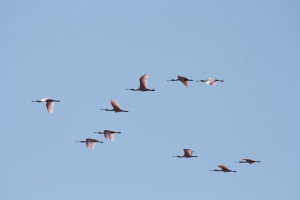As we start 2016, I’m trying to be more conscious of conservation issues that I interact with on a regular basis but might not really spend a lot of time contemplating in detail. For example, I know that carbon dioxide emissions are a major cause of global warming, so I try to turn off lights when they aren’t in use and put on an extra layer when it’s cold outside to reduce energy consumption, but it took me a good chunk of time to really think about how many freezer bags I use once and then toss when I’m storing and then cooking food.

Spoonbills are beautiful birds that seem a bit wary of human presence- perhaps they have a good reason?
So much of my work concerns systems on the very edges of Louisiana- barrier islands and beaches that are constantly changing and being lost a bit at a time to erosion, subsidence, and sea level rise. I focus on the carnivores that survive in this dynamic landscape, but many more people are interested in the colonial seabirds that nest and/or winter on the shore- pelicans, terns, plovers, egrets- many different birds with a variety of food sources, behaviors, and habitat needs. But all of them utilize a coastal zone that is steadily disappearing- they share what remains with predators, prey, and lots of human activity. Under those conditions, it seems reasonable to wonder how they are faring, so this month I will be looking at the survival of colonial seabirds here in Louisiana and around the world.
Based on my time in the field, I know that some seabird species like to nest in trees and shrubs, while others prefer beach areas. I also know they can be very loud, messy, and quick to defend the colony if they feel threatened. I know that Louisiana regularly surveys colonies and wintering areas to count birds and nests, and there are several island and beach restoration projects in the areas where I work which were created, in part, to provide more or better nesting habitat- all of this attention suggests that there are concerns about colony survival. Certainly I have seen some nesting islands all but disappear over the course of three years in the field under the constant onslaught of wind and water, so I can understand the concern. But is it all about nesting locations or places to rest on the beach? What about food supplies, invasive species, or seclusion from humans?
This month I want to better understand the issues facing colonial seabirds where I live and around the world, to really consider the situation facing birds I see all of the time and what I can do to strengthen their hand.
